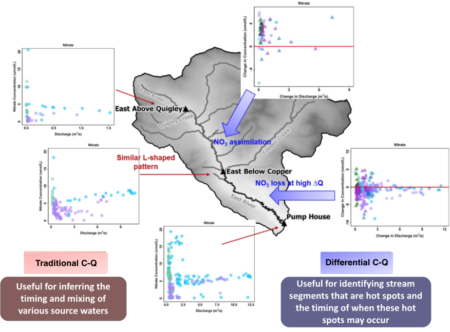
A comparison of traditional C-Q patterns for nitrate across individual stations and differential C-Q approach across the upstream and downstream reaches encompassing those stations. The C-Q patterns show a consistent L-shaped pattern for nitrate across all three stations of the East River Catchment. In comparison, differential C-Q shows gains in nitrate in the upstream reach and losses in the downstream reach during high gains in discharge.
An easy-to-use C-Q approach has been developed that can account for gains, losses and/or fractional solute turnover over each stream segment. This new approach is found to yield a better accounting of the specific sources, hillslope contributions and critical stream segments that can adversely impact river water quality than traditional approaches.
The differential C- Q analysis is a valuable tool for assessing differences across stream reaches, comparing accumulation and mobilization of harmful chemicals within and across reaches, and monitoring solute behavior in the face of hydrologic and climatic perturbations. This approach can therefore aid watershed and land managers in identifying the stream segments that are essential to monitor and for designing pollution prevention/intervention strategies.
Summary
Concentration-discharge (C-Q) relationships are often used to describe how water moves through streams and the chemicals that are transported with it. These relationships are typically examined at individual sampling stations, which do not provide sufficient information about accumulation or mobilization of harmful chemicals, pesticides or other solutes. In this study, we present a new differential C-Q approach that can capture the increase, decrease, and/or the fractional solute turnover over each stream segment. To evaluate and compare this differential approach with traditionally-used approaches, water quality data collected at the East River CO watershed was used. The traditional C-Q patterns showed a consistent L-shaped pattern for nitrate across three stations of the East River watershed. In comparison, differential C-Q approach showed gains in nitrate in the upstream reach and losses in the downstream reach during high gains in discharge. In contrast to nitrate, gains in phosphate, organic carbon, molybdenum and several other solutes were observed in the downstream reach due to its low-relief, meandering terrain. In this manner, the new C-Q approach clearly indicated when and where small increases in nutrients like phosphorus and nitrate can be particularly concerning given the potential for algal growth and eutrophication. Overall, the differential C-Q approach holds potential for aiding water quality managers in the identification of critical stream reaches that assimilate harmful chemicals.
Citation
B. Arora, M. Burrus, M. Newcomer, C. I. Steefel, R. W. H. Carroll, D. Dwivedi, W. Dong, K. H. Williams, and S. S. Hubbard (2020), Differential CQ Analysis: A New Approach to Inferring Lateral Transport and Hydrologic Transients within Multiple Reaches of a Mountainous Headwater Catchment. Front. Water 2: 24, DOI: 10.3389/frwa .2020.00024
